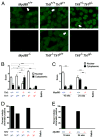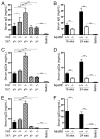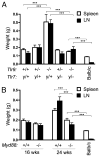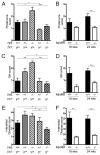TLR9 regulates TLR7- and MyD88-dependent autoantibody production and disease in a murine model of lupus
- PMID: 20089701
- PMCID: PMC4098568
- DOI: 10.4049/jimmunol.0902592
TLR9 regulates TLR7- and MyD88-dependent autoantibody production and disease in a murine model of lupus
Abstract
Systemic lupus erythematosus is characterized by the production of autoantibodies against nucleic acid-associated Ags. We previously found that Tlr7 was required for anti-Sm and Tlr9 for anti-chromatin autoantibodies. Yet, although Tlr7 deficiency ameliorated disease, Tlr9 deficiency exacerbated it. Despite the mechanistic and clinical implications of this finding, it has yet to be elucidated. In this study, we characterize MRL/lpr lupus-prone mice genetically deficient in Tlr7, Tlr9, both Tlr7 and Tlr9, or Myd88 to test whether Tlr7 and Tlr9 function independently or instead regulate each other. We find that disease that is regulated by Tlr9 (and hence is worse in its absence) depends on Tlr7 for its manifestation. In addition, although Tlr7 and Tlr9 act in parallel pathways on different subsets of autoantibodies, Tlr9 also suppresses the production of Tlr7-dependent RNA-associated autoantibodies, suggesting previously unrecognized cross-regulation of autoantibody production as well. By comparing disease in mice deficient for Tlr7 and/or Tlr9 to those lacking Myd88, we also identify aspects of disease that have Tlr- and Myd88-independent components. These results suggest new models for how Tlr9 regulates and Tlr7 enhances disease and provide insight into aspects of autoimmune disease that are, and are not, influenced by TLR signals.
Conflict of interest statement
The authors have no financial conflicts of interest.
Figures







Similar articles
-
Opposing impact of B cell-intrinsic TLR7 and TLR9 signals on autoantibody repertoire and systemic inflammation.J Immunol. 2014 May 15;192(10):4525-32. doi: 10.4049/jimmunol.1400098. Epub 2014 Apr 7. J Immunol. 2014. PMID: 24711620 Free PMC article.
-
Toll-like receptor 7 and TLR9 dictate autoantibody specificity and have opposing inflammatory and regulatory roles in a murine model of lupus.Immunity. 2006 Sep;25(3):417-28. doi: 10.1016/j.immuni.2006.07.013. Immunity. 2006. PMID: 16973389
-
Toll-like receptor 7 (TLR7) modulates anti-nucleosomal autoantibody isotype and renal complement deposition in mice exposed to syngeneic late apoptotic cells.Ann Rheum Dis. 2010 Jun;69(6):1195-9. doi: 10.1136/ard.2009.108282. Epub 2009 Aug 11. Ann Rheum Dis. 2010. PMID: 19674980 Free PMC article.
-
Emerging roles of TLR7 and TLR9 in murine SLE.J Autoimmun. 2009 Nov-Dec;33(3-4):231-8. doi: 10.1016/j.jaut.2009.10.001. Epub 2009 Oct 21. J Autoimmun. 2009. PMID: 19846276 Review.
-
Toll-like receptor signalling in B cells during systemic lupus erythematosus.Nat Rev Rheumatol. 2021 Feb;17(2):98-108. doi: 10.1038/s41584-020-00544-4. Epub 2020 Dec 18. Nat Rev Rheumatol. 2021. PMID: 33339987 Free PMC article. Review.
Cited by
-
Nucleic acid-sensing toll-like receptors: Important players in Sjögren's syndrome.Front Immunol. 2022 Oct 31;13:980400. doi: 10.3389/fimmu.2022.980400. eCollection 2022. Front Immunol. 2022. PMID: 36389822 Free PMC article. Review.
-
A tolerogenic role for Toll-like receptor 9 is revealed by B-cell interaction with DNA complexes expressed on apoptotic cells.Proc Natl Acad Sci U S A. 2012 Jan 17;109(3):887-92. doi: 10.1073/pnas.1109173109. Epub 2011 Dec 29. Proc Natl Acad Sci U S A. 2012. PMID: 22207622 Free PMC article.
-
Recent clinical trends in Toll-like receptor targeting therapeutics.Med Res Rev. 2019 May;39(3):1053-1090. doi: 10.1002/med.21553. Epub 2018 Nov 18. Med Res Rev. 2019. PMID: 30450666 Free PMC article. Review.
-
Alpha 1 Antitrypsin Gene Therapy Extends the Lifespan of Lupus-Prone Mice.Mol Ther Methods Clin Dev. 2018 Oct 18;11:131-142. doi: 10.1016/j.omtm.2018.10.007. eCollection 2018 Dec 14. Mol Ther Methods Clin Dev. 2018. PMID: 30547047 Free PMC article.
-
Trafficking of endosomal Toll-like receptors.Trends Cell Biol. 2014 Jun;24(6):360-9. doi: 10.1016/j.tcb.2013.12.002. Epub 2014 Jan 15. Trends Cell Biol. 2014. PMID: 24439965 Free PMC article. Review.
References
-
- Miyake K. Innate immune sensing of pathogens and danger signals by cell surface Toll-like receptors. Semin Immunol. 2007;19:3–10. - PubMed
-
- Krieg AM, Vollmer J. Toll-like receptors 7, 8, and 9: linking innate immunity to autoimmunity. Immunol Rev. 2007;220:251–269. - PubMed
-
- Krug A. Nucleic acid recognition receptors in autoimmunity. Handb Exp Pharmacol. 2008;38:129–151. - PubMed
-
- Kaisho T, Tanaka T. Turning NF-κB and IRFs on and off in DC. Trends Immunol. 2008;29:329–336. - PubMed
-
- Fischer M, Ehlers M. Toll-like receptors in autoimmunity. Ann N Y Acad Sci. 2008;1143:21–34. - PubMed
Publication types
MeSH terms
Substances
Grants and funding
LinkOut - more resources
Full Text Sources
Other Literature Sources
Medical
Molecular Biology Databases

